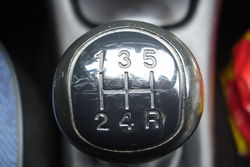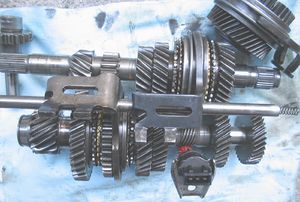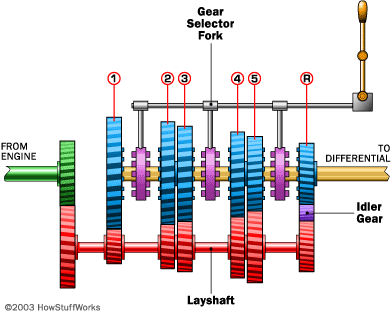Transmission (vehicle)

- Manual transmissions are discussed in this article, visit How Stuff Works to learn about automatic transmission.
Transmission is used in cars to vary the torque going from the engine to the drive wheels. It is an important part of the drive train.
Cars require a transmission because their engine has a maximum RPM that it can spin at before damage occurs, known as redline (specifically, RPM is a measure of the rotating crankshaft). Second, every engine has a certain RPM at which it produces maximum horsepower and torque.[2] In order to operate at a suitable RPM, a transmission makes use of gears; the gears vary how much torque and angular velocity is transmitted from the engine to the wheel, therefore allowing the RPM to remain below redline while also providing maximum horsepower.
Operation

Transmissions use what is called a gear ratio, which is a measure of the mechanical advantage their gears produce. The higher the gear ratio, the less angular velocity (meaning a lower RPM value) is being transmitted to the drive shaft, but this comes with a proportionally higher torque. A high gear ratio is desirable at low speeds, so that the wheels won't be spinning too fast while also getting enough torque to get the car moving. A low gear ratio is desirable to deliver maximum speed to the wheels, and therefore would be used at higher speeds when the wheels don't need as much torque. This ratio is given by
where
- is the gear ratio
- is the rotational speed of the engine in RPM
- is the rotational speed of the output shaft in RPM
- is the torque of the engine
- is the torque to the output shaft
A table containing the corresponding gear ratio for a typical 5-speed car's gears if the engine is at 3,000 RPM:[2]
| Gear | Ratio | RPM at Output Shaft |
|---|---|---|
| 1st | 2.315:1 | 1,295 |
| 2nd | 1.568:1 | 1,913 |
| 3rd | 1.195:1 | 2,510 |
| 4th | 1.000:1 | 3,000 |
| 5th | 0.915:1 | 3,278 |
Parts

The transmission of a car has many working parts (clutch, layshaft etc.) but in principle is quite simple—use gears to vary how much torque gets to the wheels. Mentioned above was how this is done in terms of gear ratio, so below is a list of the working parts in a transmission and their role to accomplish this task. First, the input shaft (green part of Figure 3) coming from the engine will be spinning at the same speed as the engine.[2] The first important part is what connects this to the transmission, and allows for the engine to run while the car is standing still.
- Clutch- The clutch is a major component of a manual transmission, and it is used often. Its purpose is to connect or disconnect the engine from the transmission. When disconnected, the engine will spin on its own and no power will be delivered to the wheels, which allows for gear changes, and for the car to run while not moving. When connected, the clutch connects the two systems and allows for power transfer and acceleration to occur.
- Layshaft- The layshaft (red) connects to the engine via the clutch, and spins as one unit. Therefore when the clutch is engaged, the layshaft will spin as long as the engine is running, and any change in engine speed will be relayed to the layshaft. It connects to the next part, which is what gets the car moving.
- Gears and output shaft- The gears (blue) and output shaft (yellow) are what connect to the drive shaft, differential, and finally the wheels. The shaft and gears do not spin as a single unit unless the purple part, known as the collar, is locked with a gear.
- Collar- This part is crucial for the main goal of the transmission, which is to get the wheels moving at the desired speed. If the collar isn't connected to a gear, as in Figure 3, the car is considered to be in "neutral", and the engine will provide no power to the wheels. It connects to the gear by its "dog teeth", and if you've ever heard a manual car grind during gear change it is these dog teeth attempting to lock into a gear. In modern cars, they use synchronizers to make the change of gears smoother.
- Gear selector fork- This is what the driver uses to change the gears, seen in Figure 1. The moving of this fork changes the position of the collar, and allows the driver to change gears only when the clutch is disengaged. In Figure 3 it can be seen how a car goes in reverse, because the "idler gear" causes the reverse gear to spin in the opposite direction from the others.
For Further Reading
For further information please see the related pages below:
- Fuel efficiency
- Torque
- Drive train (there's a fun video explaining differentials there)
- Drive shaft
- Or explore a random page
References
- ↑ Wikimedia Commons [Online], Available: http://en.wikipedia.org/wiki/Transmission_(mechanics)#/media/File:Cambio_H.jpg
- ↑ 2.0 2.1 2.2 How Stuff Works, How Manual Transmissions Work [Online], Available: http://auto.howstuffworks.com/transmission.htm
- ↑ Wikimedia Commons [Online], Available: http://en.wikipedia.org/wiki/Transmission_(mechanics)#/media/File:Cambio_H.jpg
- ↑ How Stuff Works, A real transmission [Online], Available: http://auto.howstuffworks.com/transmission4.htm

